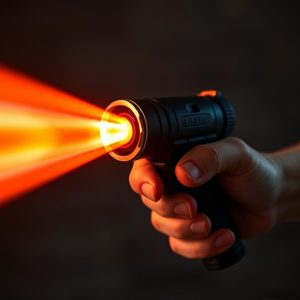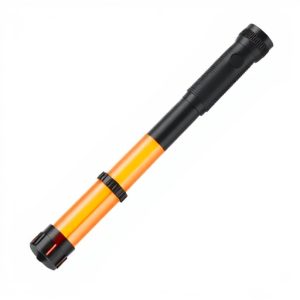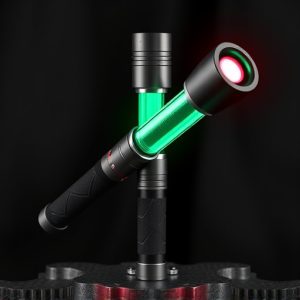Repeller Stun Baton: A Non-Lethal Self-Defense Guide and Comparative Analysis
The Repeller Stun Baton is a modern self-defense device that offers a non-lethal alternative to tra…….
The Repeller Stun Baton is a modern self-defense device that offers a non-lethal alternative to traditional stun guns. It emits high-frequency sound waves or electromagnetic pulses to disorient and incapacitate attackers temporarily without causing significant harm. This innovative technology allows for personal space preservation and reduces potential cross-contamination, making it a relevant choice in health-conscious environments. The baton is designed with safety and effectiveness in mind, featuring advanced electronics for precise sound or electrical wave emission, user-friendly operation, and adjustable settings for different situations. Some models come with a built-in flashlight to improve visibility during confrontations. It's important to note that while the device is a sophisticated tool for personal security, its effectiveness can vary depending on environmental factors, and users must be trained to handle it responsibly. Legal considerations dictate that one must be aware of local laws regarding its use, as the status of these devices differs by jurisdiction. Ethical use is paramount, ensuring the device is employed only when necessary for self-defense and not for abuse or harm disproportionate to the threat. Regular maintenance and practice are essential to ensure the Repeller Stun Baton remains a reliable defense mechanism.
When faced with potentially dangerous situations, the need for effective personal protection is paramount. Among the array of self-defense tools available, the repeller stun baton emerges as a non-lethal weapon that offers a compelling solution. This article delves into the intricacies of the repeller stun baton, exploring its features, functionality, and the legal and ethical implications associated with its use. We will compare it to other non-lethal defense mechanisms, highlighting its advantages and potential drawbacks. Whether considering personal safety or law enforcement applications, understanding the repeller stun baton is crucial for those seeking a reliable alternative to more aggressive options. Join us as we navigate the critical aspects of this defensive technology.
Understanding the Repeller Stun Baton: A Non-Lethal Defense Solution
The Repeller Stun Baton stands as a pivotal non-lethal defense solution for individuals seeking to protect themselves in potentially harmful situations. Unlike traditional stun devices, which rely on electric shocks, the repeller technology emits a high-frequency sound wave capable of incapacitating an attacker without causing permanent injury. This innovative approach leverages the power of acoustic energy to create an intolerable audio environment that disorients and deters assailants, rendering them defenseless while minimizing the risk of escalation or unintended harm.
This device is engineered with precision and safety in mind, utilizing advanced electronics to generate a targeted sound wave that can be directed at an aggressor from a distance. The repeller stun baton is compact, easy to handle, and can be a reliable deterrent during encounters where verbal warnings or escape are not viable options. Its effectiveness lies in the discomfort caused by the high-frequency noise, which affects the auditory system of the perpetrator, leading to an immediate cessation of threatening behavior. The repeller stun baton is a testament to the evolving landscape of personal safety tools, offering users a non-lethal alternative that prioritizes both personal defense and ethical considerations.
Key Features of the Repeller Stun Baton and How It Works
The repeller stun baton is a sophisticated self-defense tool that employs high-voltage electric shocks to incapacitate an attacker, serving as a non-lethal deterrent. This device is designed with key features that enhance its functionality and user safety. It typically incorporates a rechargeable battery system, ensuring a reliable energy supply for the stun capability. The baton’s design often includes multiple electrode points along its length, which can deliver the electric current at various contact points, increasing the chances of effective incapacitation without causing permanent harm. The intensity of the shock is adjustable on some models, allowing users to select a setting that suits the situation and minimizes risk. The repeller stun baton also features a built-in flashlight, which not only aids in visibility during confrontations but also serves as an additional safety feature. This dual function can be critical in scenarios where both self-defense and navigation may be required.
The operation of the repeller stun baton is based on the principles of electrolocation. When activated, it releases a high-voltage, low-ampere electrical charge that passes through the attacker’s body. This discharge interferes with the neural messages between the brain and the muscles, causing involuntary muscle contractions and intense pain, effectively neutralizing the threat without lethal force. The device is also equipped with a safety switch to prevent accidental discharges and a stun mode that can be activated separately from the light function. The baton’s ergonomic design ensures it is comfortable to hold and maneuver, even in tense situations. Additionally, its bright LED lights can disorient an aggressor, providing an additional layer of defense. Users can confidently rely on the repeller stun baton as a dependable self-defense tool due to its robust construction, user-friendly interface, and effective electrical output.
The Legality and Ethical Considerations of Using a Repeller Stun Baton
The deployment of a repeller stun baton as a non-lethal weapon raises both legal and ethical questions that are critical for its application in various scenarios. Legally, the use of such devices is governed by a patchwork of laws across different jurisdictions. In some regions, stun batons are considered legal self-defense tools within certain parameters, while in others, their possession may be restricted or outright prohibited. The legality often hinges on the context of the use and the specific regulations set forth by local authorities. It is imperative for potential users to familiarize themselves with the applicable laws to avoid legal repercussions.
From an ethical standpoint, the use of a repeller stun baton involves weighing the immediate need for self-defense or crowd control against the long-term implications for personal safety and public order. Ethical considerations extend to the potential for misuse by law enforcement or individuals in power. The consequences of incorrect application can range from minor injuries to severe harm, depending on factors like the environment, the target’s physical condition, and the wielder’s skill level. As such, ethical guidelines must be established and consistently applied to ensure that these tools are used responsibly and for their intended purpose: to deter, incapacitate temporarily, and protect without causing permanent harm. The ongoing dialogue about the appropriate use of repeller stun batons in various settings is a testament to the dynamic nature of this issue, with new regulations and ethical frameworks continually evolving to address public safety and individual rights.
Effective Use and Training with the Repeller Stun Baton
The repeller stun baton is a sophisticated self-defense tool that emits an electromagnetic pulse to incapacitate potential attackers, offering a non-lethal alternative for personal security. Effective use of this device requires specialized training to ensure safety and efficacy. Proper handling involves understanding the stun baton’s mechanical components, such as the voltage settings and electric probe capabilities, which can be overwhelming at first glance but become intuitive with practice. Law enforcement agencies and self-defense instructors often provide training courses that cover situational awareness, targeting techniques, and the legal implications of using a repeller stun baton in defensive scenarios. These courses emphasize the importance of using the device responsibly and only when there is an immediate threat to one’s personal safety. Training also includes maintaining the equipment in optimal condition, which involves regular maintenance checks and adhering to the manufacturer’s guidelines for battery replacement and storage to ensure the stun baton is always ready for use when needed. Users must commit to ongoing practice to become proficient with the repeller stun baton, ensuring they are well-prepared to deploy it effectively should the need arise.
Comparing the Repeller Stun Baton to Other Non-Lethal Weapons: Advantages and Disadvantages
The Repeller Stun Baton distinguishes itself in the non-lethal weapon market through its unique mode of operation. Unlike traditional stun devices that rely on electrical current, the repeller technology emits a high-frequency energy pulse that incapacitates an assailant without physical contact. This feature provides several advantages over other non-lethal options. For instance, the repeller’s non-touch activation from a distance deters attackers while preserving personal space and reducing the risk of cross-contamination, which is particularly beneficial in the wake of health consciousness and pandemic concerns. However, this technology also comes with its own set of considerations; the effectiveness may vary based on environmental factors such as humidity or the presence of conductive materials, which can potentially affect the energy pulse’s range and potency. Moreover, while it is a less invasive method than Tasers, the repeller still requires users to be within an effective distance to utilize its defense capabilities, unlike pepper spray that can be deployed from farther away. Users must also be trained to handle the device appropriately to ensure safety for both the user and the target. In comparison to other non-lethal weapons, the Repeller Stun Baton offers a high level of personal security with its advanced technology, yet it requires users to account for situational variables and maintain proficiency in its use.


